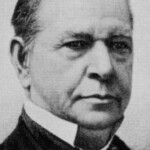
Introduction to the Winchester-Lee Model 1895
The Winchester-Lee Model 1895, commonly known as the Lee Navy Rifle, was one of the most advanced military firearms of its era. Designed by James Paris Lee, the inventor of the detachable box magazine, and manufactured by Winchester Repeating Arms Company, this straight-pull bolt-action rifle was a significant departure from the conventional turn-bolt designs that dominated late 19th-century military arsenals. It was a rifle ahead of its time—high-velocity, clip-fed, and more advanced than its contemporaries. Despite its innovations, the rifle’s service life was relatively brief, but its impact on future firearm development was undeniable.
Development and Manufacturing
The Winchester-Lee Model 1895 was developed in response to the U.S. Navy’s search for a modern, smokeless-powder rifle to replace outdated black powder weapons. At the time, militaries worldwide were transitioning to small-bore, high-velocity cartridges, and the U.S. Navy sought a cutting-edge design that could match European advancements.
Manufactured from 1895 to 1902 at Winchester’s New Haven, Connecticut factory, the Lee Model 1895 saw limited but important production numbers. Approximately 20,000 rifles were built, with the majority issued to the U.S. Navy and the Marine Corps. A small number were sold commercially and to foreign buyers, but its primary use remained with American naval forces.
Straight-Pull Bolt Action: A Unique Mechanism
The Winchester-Lee Model 1895 employed a straight-pull bolt action, a departure from traditional turn-bolt systems like the Mauser 1893 and Krag-Jorgensen. Unlike turn-bolt actions that required the user to rotate and then pull back the bolt, the Lee Model 1895’s action allowed the shooter to pull straight back and push forward in one motion, increasing the speed of cycling.
While the straight-pull design enabled a higher rate of fire, it had inherent weaknesses. The complex locking mechanism made it more susceptible to dirt and fouling, reducing battlefield reliability. Additionally, the rifle's split bridge receiver allowed for rapid bolt movement but sacrificed structural integrity compared to Mauser-type designs.
The 6mm Lee Navy Cartridge: An Advanced but Flawed Round
The Winchester-Lee Model 1895 was chambered for the 6mm Lee Navy cartridge (.236 Navy), one of the first high-velocity smokeless powder rounds adopted by the U.S. military. This round featured a 112-grain bullet propelled at 2,560 feet per second, offering a flat trajectory and excellent penetration. It was an innovative cartridge for its time, providing greater range and velocity than contemporary service rounds like the .30-40 Krag.
However, the 6mm Lee Navy suffered from significant drawbacks:
- Terminal ballistics issues: The light bullet often lacked stopping power, particularly in the Philippine-American War, where U.S. Marines reported inadequate performance against Moro warriors.
- Semi-rimmed case design: The unique case shape made it less adaptable for widespread adoption in future military rifles.
- Barrel erosion: Early smokeless powders burned hotter than black powder, leading to accelerated barrel wear in the 6mm Lee Navy.
By 1899, the U.S. military recognized these deficiencies, and by 1906, the 6mm Lee Navy was officially phased out in favor of the .30-06 Springfield, a round that would serve the U.S. military for over half a century.
Military Use and Combat Performance
The Winchester-Lee Model 1895 saw active service in several conflicts, most notably the Spanish-American War (1898), the Philippine-American War (1899-1902), and the Boxer Rebellion (1899-1901). It was issued to U.S. Marines and sailors, particularly those stationed aboard naval vessels and in expeditionary units.
Advantages in Combat:
- Rapid rate of fire: The straight-pull bolt and five-round en bloc clip allowed for faster cycling compared to the Krag-Jorgensen’s side-loading magazine.
- High-velocity cartridge: The 6mm Lee Navy offered superior penetration at long distances, making it effective against enemy combatants in open terrain.
- Light recoil: The small-caliber round allowed for easier follow-up shots and improved accuracy.
Disadvantages in Combat:
- Delicate extraction system: The Lee Navy’s extractor was prone to breakage, especially in the humid and rough conditions of the Philippines.
- Stopping power concerns: The lightweight, high-speed bullet often failed to incapacitate adversaries quickly, leading to calls for a return to heavier calibers.
- Ammunition logistics issues: The Navy had trouble supplying adequate 6mm ammunition, leading to inconsistent availability in combat zones.
Comparison to the Krag-Jorgensen Rifle
The Winchester-Lee Model 1895 was issued alongside the Krag-Jorgensen rifle, which was the standard U.S. Army service rifle at the time. The two rifles had distinct strengths and weaknesses:
| Feature | Winchester-Lee Model 1895 | Krag-Jorgensen |
|---|---|---|
| Action Type | Straight-pull bolt | Turn-bolt |
| Magazine System | 5-round en bloc clip | 5-round side gate |
| Cartridge | 6mm Lee Navy (.236) | .30-40 Krag |
| Rate of Fire | Faster due to straight-pull | Slower due to turn-bolt action |
| Stopping Power | Weaker (light bullet) | Stronger (heavier bullet) |
| Battlefield Durability | Less reliable under harsh conditions | More rugged and field-tested |
While the Lee Navy offered superior firepower and a higher rate of fire, the Krag-Jorgensen was ultimately deemed more reliable and remained in service longer, until it was replaced by the M1903 Springfield.
Legacy and Influence
Despite its short-lived service, the Winchester-Lee Model 1895 had a lasting impact on firearm development. It was one of the earliest clip-fed, high-velocity military rifles, setting a precedent for later semi-automatic and automatic weapons. Some of its innovations, such as the fast-loading en bloc clip system, were later refined in the M1 Garand.
Today, surviving examples of the Winchester-Lee Model 1895 are highly sought after by collectors. Its rarity, combined with its historical significance, makes it one of the most fascinating firearms of the late 19th century.
Conclusion
The Winchester-Lee Model 1895 remains an overlooked but pivotal rifle in American military history. Designed by James Paris Lee, produced by Winchester, and used by the U.S. Navy and Marine Corps, it introduced several groundbreaking features that were ahead of their time. While its high-velocity 6mm cartridge was ultimately short-lived, the rifle’s influence on later firearm designs is undeniable. Its straight-pull bolt action, rapid reload capability, and military service in major conflicts cement its place in the evolution of modern infantry rifles.
For firearm historians, military enthusiasts, and collectors alike, the Winchester-Lee Model 1895 remains a symbol of innovation, bridging the gap between early bolt-action rifles and the later semi-automatic weapons that would dominate 20th-century warfare.
Read more about the Winchester-Lee 1895 here:
If you know of any forums or sites that should be referenced on this listing, please let us know here.







